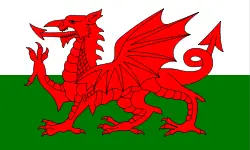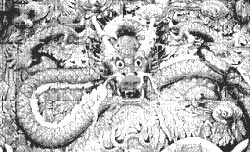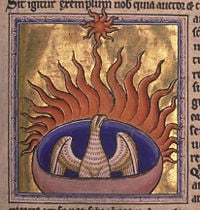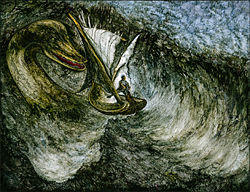Mythical creature
A mystical, mythical, or legendary creature is a creature from mythology or folklore (often known as "fabulous creatures" in historical literature). Some — such as the dragon or the griffin — have their origin in traditional mythology and have at one time been believed to be real creatures. Others were based on real creatures, originating in garbled accounts of travelers' tales; such as the Vegetable Lamb of Tartary, which supposedly grew tethered to the earth (and was actually a type of fern). The traditional unicorn may have come from garbled stories about the rhinoceros and/or narwhal. Examples of the legendary creatures can be found in medieval bestiaries.
Conversely, some creatures downplayed as just storytelling, have been rediscovered and found to be real in recent times, such as the giant squid.
Often mythical creatures are chimeras, a combination of two or more animals. Some of these are combinations of a human being and one or more other creatures. For example, a centaur is a combination of a man and horse, a minotaur of a man andbull. It should be noted that these were not always intended to be understood as literal juxtapositions of parts from disparate species. Lacking a common morphological vocabulary, classical and medieval scholars and travelers would attempt to describe unusual animals by comparing them point-for-point with familiar: the giraffe, for example, was called cameleopard, and thought of as a creature half-camel, and half-leopard.
Many legendary creatures appear prominently in fantasy fiction. These creatures are often claimed to have supernatural powers or knowledge or to guard some object of great value, which becomes critical to the plot of the story in which it is found.
Many legendary creatures have been incorporated into heraldry and architectural decoration. Legendary creatures have also been accepted into many facets of popular culture most notably in fantasy role playing games such as Dungeons & Dragons or Everquest, video games, Hollywood movies and power metal bands (such as DragonForce)).
Examples
Birds and serpents
- Basilisk
- Most often depicted as a reptile, the basilisk is reputed to be king of serpents. One of the most feared of all mythological beasts, a basilisk is said to have the power to cause death with a single glance. In this aspect it bears similarity to the Gorgons of Greek mythology.
- Chinese dragon
- Also appearing in other East Asian cultures, it is also sometimes called the Oriental (or Eastern) dragon. The Chinese dragon is easily recognizable for its long serpentine body that is generally wingless, and its anthropomorphic face, complete with beard. The oriental dragon is generally considered a supernatural or spiritual symbol of heavenly power.
- Dragon
- Typically depicted as a large and powerful Serpent or other reptile it has magical or spiritual qualities, the most famous being the ability to breathe fire from their mouths. More often than not dragons were considered malevolent, associated with evil supernatural forces and the natural enemy of humanity.
- Feng-huang
- Sometimes called the Chinese Phoenix, the feng-huang is a symbol of summer and spiritual balance, and along with the dragon, qilin and tortoise, is one of the most high revered creatures in Chinese tradition. Its appearance is said to indicate some great event, or to bear testimony to the greatness of a ruler. It is often viewed as the sacred union of male and female, Feng being male and Huang female, but also the Feng-Huang can be regarded as a female entity in relation with the male dragon.
- Phoenix
- Characterized as a bird with brightly colored plumage, after a long life the phoenix dies in a fire of its own making only to rise again from the ashes.
- Ziz
- A giant bird in Jewish mythology, the ziz is the counterpart in the air of the Behemoth (giant creature of land) and Leviathan (giant creature of water). The Ziz is said to be large enough to be able to block out the sun with its wingspan.
Lake monsters
Lake monster or loch monster is the name given to large unknown animals which have purportedly been sighted in, and/or are believed to dwell in freshwaters, although their existence has never been confirmed scientifically. They are generally believed not to exist by conventional zoology and allied sciences, and are principally the subject of investigations by followers of cryptozoology. Sightings are often similar to some sea monsters.
Of these, Nessie of Loch Ness is almost certainly the most famous, and is promoted heavily in the area's tourist industry.
Other well known lake monsters include:
- Champ of Lake Champlain in North America
- Bessie of Lake Erie in the United States
- Chessie of Chesapeake Bay in the United States
- Ogopogo of Lake Okanagan in Canada
- Nahuelito of Nahuel Huapi Lake in Argentina
- Lake Tianchi Monster of Heaven Lake (known as Tianchi (天池) in Chinese and Chonji (천지) in Korean) on the border of China and North Korea
- Isshii of Lake Ikeda in Japan
- Brosno dragon of Lake Brosno in Russia
- Mokele-mbembe of the Congo River in Congo
Monstrous creatures

- Behemoth
- Behemoth is the primal unconquerable monster of the land, as Leviathan is the primal monster of the waters of the sea and Ziz the primordial monster of the sky. There is a legend that the Leviathan and the Behemoth shall hold a battle at the end of the world. The two will finally kill each other, and the surviving men will feast on their meat.
- Leviathan
- Leviathan is a Biblical sea monster, referred to in sections of the Old Testament. It is regarded as the monster of the waters, while the Behemoth and the Ziz are regarded as monsters of the earth and the air, respectively.
Chimeras
Animal
Part-human
Humanoid creatures
- Banshee
- Dwarf
- Elf
- Fairy
- Gnome
- Goblin
- Leprechaun
- Nymph
- Ogre
- Orc
- Pixie
- Sasquatch
- Troll
- Vampire
- Werewolf
- Wendigo
- Yeti
Other
- Kelpie a supernatural shape-shifting water horse from Celtic folklore
ReferencesISBN links support NWE through referral fees
- Ashman, Malcolm and Joyce Hargreaves. 1997. Fabulous Beasts. Overlook. ISBN 978-0879517793
- Barber, Richard. 2006. Bestiary: Being an English Version of the Bodleian Library, Oxford, MS Bodley 764. Boydell Press. ISBN 978-0851157535
- Borges, Jorge Luis. 2005. The Book of Imaginary Beings. Amazon Remainders. ISBN 0670891800
- Conway, D.J. 2001. Magickal Mystical Creatures: Invite Their Powers Into Your Life. Llewellyn Publications. ISBN 156718149X
- Costello, Peter. 1979. The Magic Zoo: The Natural History of Fabulous Animals. St. Martin's Press. ISBN 0312504217
- Dubois, Pierre, Claudine Sabatier, and Roland Sabatier. 2000. The Great Encyclopedia Of Faeries. Simon & Schuster. ISBN 0684869578
- Eason, Cassandra. 2002. A Complete Guide to Faeries & Magical Beings: Explore the Mystical Realm of the Little People. Boston, MA: Red Wheel/Weiser. ISBN 978-1578632671
- Ellis, Richard. 2006. Monsters of the Sea. The Lyons Press. ISBN 978-1592289677
- Evans-Wentz, W. Y. 2004. The Fairy-Faith in Celtic Countries. New Page Books. ISBN 978-1564147080
- Hassig, Debra. 2000. The Mark of the Beast: The Medieval Bestiary in Art, Life, and Literature. Routledge. ISBN 041592894X
- Keightley, Thomas. 2000. The World Guide to Gnomes, Fairies, Elves & Other Little People. Gramercy. ISBN 0517263130
- Nigg, Joe. 1995. Wonder Beasts: Tales and Lore of the Phoenix, the Griffin, the Unicorn, and the Dragon. Libraries Unlimited. ISBN 156308242X
- Nigg, Joseph. 1999. The Book of Fabulous Beasts: A Treasury of Writings from Ancient Times to the Present. Oxford University Press, USA. ISBN 978-0195095616
- Nigg, Joe. 2001. The Book of Dragons & Other Mythical Beasts. Barron's Educational Series. ISBN 978-0764155109
External links
Credits
New World Encyclopedia writers and editors rewrote and completed the Wikipedia article in accordance with New World Encyclopedia standards. This article abides by terms of the Creative Commons CC-by-sa 3.0 License (CC-by-sa), which may be used and disseminated with proper attribution. Credit is due under the terms of this license that can reference both the New World Encyclopedia contributors and the selfless volunteer contributors of the Wikimedia Foundation. To cite this article click here for a list of acceptable citing formats.The history of earlier contributions by wikipedians is accessible to researchers here:
The history of this article since it was imported to New World Encyclopedia:
Note: Some restrictions may apply to use of individual images which are separately licensed.



